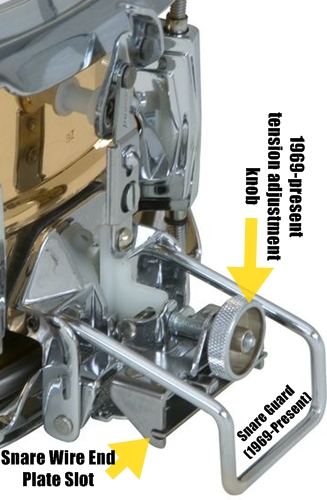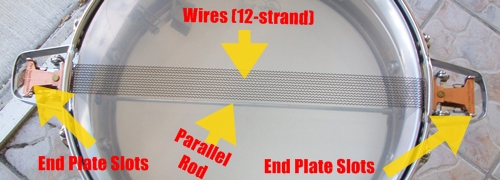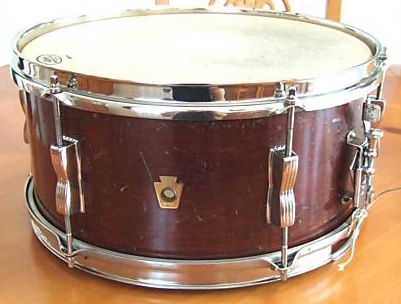After wrapping up my
three part series on brush DVDs in my last post I will take care of dangling wires in this one by discussing the heads and brush models that I prefer.
The best head I have ever used for brush playing is the Aquarian Texture Coated drumhead. The trademarked Satin Finish on this head makes it a joy to use with brushes; however, when playing this head with sticks it has a plastic sound to my ears. So, while I would use it on a brush-only gig, I have yet to have such a playing opportunity. One advantage to the Aquarian Texture Coated head is the fact that it needs very little break-in time when you mount a new head.
My go to head is the Remo coated Ambassador. I have used this head for as long as I can remember, and it sounds just fine to my ears for both brush and stick playing. However, unlike the Aquarian Texture Coated head, the coated Ambassador needs some break-in time after you mount a new one. I usually spend about an hour with a new head to break it in before using it in a live playing situation. Some drummers will lightly sand a new Ambassador to hasten the break-in period, but I prefer to not go that route because it shortens the life of the head. Moreover, I have gotten Ambassadors that lose the coating prematurely (apparently from a batch that slipped by their quality assurance department), making the sanding technique iffy.
Other heads that I like with brushes are calf skin (see my post titled, More on Calfskin Heads), Remo's Fiberskyn Diplomat, Skyntone, and Renaissance heads in both Diplomat and Ambassador weights.
Among the choices cited above, the Skyntone head has sufficient texture to use with most brushes, while the other choices have less texture with which to produce the soup stirring, legato sweeps we commonly associate with ballads. Personally, I manage to get the sound I want from any of them, but if you want a bit more projection there are two brush models that will allow you to attain it with some of the smoother heads: the Vic Firth Steve Gadd Wire Brush and the Zildjian SDWB3 Bent Bristle Brushes. I personally dislike the feel of either brush - they are too thick for my tastes, and I am not overly fond of the balance. However, we are all different, so give them a try if you want to play brushes on a few of the heads I mentioned, but hesitate because you prefer more coating.
I like the Fiberskyn Diplomat very much. It is a warm sounding head for stick playing and also sounds nice with brushes. I use the thinner Diplomat weight because I can achieve a vintage calf skin-line sound and still get resonance that the heavier Fiberskyn Ambassador does not provide. Note: Avoid at all costs any Fiberskyn head that is a Powerstroke model. These heads have a plastic ring that kills resonance and does not work well with brushes.
The Skyntone works beautifully with both sticks and brushes. It is thin to the point where you need to be concerned if you play mainly with sticks and are a heavy hitter. While the tone I get from these heads is superb to my ears, it's possible that they will need frequent replacement. Thus far I have had no problems with them, but I am an extremely light hitter and I play mostly between PP and F. The texture is similar to genuine calfskin, including simulated pore holes.
The Renaissance Diplomat is another personal favorite (and, as with the Fiberskyn heads, avoid the Powerstroke version for brushwork). While the surface does not have the texture many brush players demand, I have used this model with regular brushes for everything from ballads to train beats. I particularly love the resonance I get from the Renaissance heads with both brushes and sticks. One caveat is these heads do not have the playing life that a coated Ambassador or even a Fiberskyn head will provide, especially if you play heavy with sticks.
Before discussing my favorite brush models, let me put a frequent question to rest. I am often asked, aren't rods better than brushes? referring to specialty sticks like the Pro-Mark Cool Rod. The answer is they are designed to do two different things. One of the essences of brush playing is to anchor the time with sweep patterns that have a legato sound. The Cool Rods are strictly staccato, and are not a replacement for brushes. Indeed, bear in mind that the approach to brush playing is totally different from stick playing, and using brushes just to achieve low volume playing isn't really brush playing at all. The best way to achieve low volume playing, if that is your goal, is to either develop your technique for achieving the dynamics for a given song, or use something like the Cool Rods.
Another question I'll attempt to answer is, Should you play brushes with the snares off or on? Quick answer: both ways work. A more drawn out answer is when I started playing in 1964 I was taught to always drop the snares when playing with brushes. When I began to take brush playing seriously I learned that you can do either. My preference is to drop the snares on ballads and for some Latin-style music, otherwise I generally keep the snares engaged. There is no right way in my opinion. Experiment and do what sounds best to you. And always let the music dictate what and how you play. So much for the Zen of Brush Playing according to Tarrani. On to my favorite brushes.
I love the feel of the Regal Tip Clayton Cameron model. In fact, at one time I used them exclusively. As my brush playing skills progressed I found that fixed brushes were too limiting because I wanted to reduce the fan of the wires on my right hand brush. This allowed me to do standard 8th note triplet patterns with my right hand while keeping time with sweeps handling the 1-2-3-4 with my left hand. That led me to retractable brushes, and the two models I have come to prefer are the Regal Tip Jeff Hamilton Signature Brushes and the Regal Tip Ed Thigpen Wire Brushes. Both feel good in my hands, and although the Ed Thigpen model is a bit heavier and thicker than I normally like, the balance is why I use it. I also like the Vic Firth Heritage Brush, which has a nice, vintage feel to it. I tried and don't care for the Vic Firth Jazz Brush because of weight and balance - you may have a different opinion since brushes - like sticks - are highly personal choices. One other brush model that I like for certain situations is the relatively new Regal Tip Yellow Jacket Retractable Brush. This model is About .5 inches shorter than the Vic Firth Heritage Brush and about the same weight. The feel is different due to the minor difference in length and the wires, which are a much lighter gauge. The wires definitely flex more and are similar to the feel of nylon, while still producing the distinctive sound that only a wire brush can provide. The wire is such a thin gauge that you may encounter problems with them falling out under heavy playing (I have heard a few such stories on various forums), so you may want to consider a pair for ballad playing on heads such as the Remo coated Ambassador because, unlike other brushes, these do not catch on new heads and require less break-in time. This model also comes in a shake out version. I don't care for any type of shake out or throw out style of brush because I never seem to get them fully extended for one thing, and I prefer my right brush to have less wire fan for the other. Also, as that style of brush wears, they tend to retract back into the handle while you are playing - definitely not a good thing!
A few tips on maintaining and using brushes: First, use the plastic tube that they came in to store them. While this is especially important for fixed brushes to extend the life of the wires and maintain them in their original shape, it applies to retractable brushes as well. I have bent more than one handle on retractable brushes because of careless storage. Second, mark your brushes so you always use the same one for your right hand, and the other for your left. This also maintains the shape of the wire fan, and extends the life because they will wear in properly. Taking this a bit further, I always make sure that I play them with the labels facing up for the same reason.
A few parting notes. First, if you travel and tend to bring a practice pad to keep your chops up, you know that brushes and standard practice pads don't work well together. Consider the Rhythm Tech Lap Top Practice Snare Drum, which is a mere 13"x1". As an alternative, you may want to consider the Sabian Quiet Tone Snare Drum Practice Pad, although it is a bit larger and heavier than the Rhythm Tech pad. Finally, since I have discussed the relationship between brush playing and tap dancing in a number of previous posts, you may find Tap with Ginger Series to be a way to tap into [pun intended] your creative side by playing along to some of the lessons. Of better, adding tap dancing to your skill set. It worked for drummers from Papa Jo Jones to Steve Gadd! Seriously, this video is an interesting play along with brushes, and since it covers beginners to expert, you can start slow and try different brush patterns against the same lessons as you work through the DVD.







